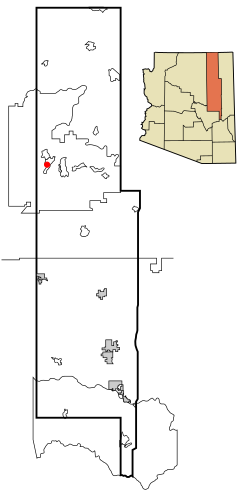Oraibi, Arizona
| Oraibi, Arizona | |
|---|---|
 Location in Navajo County and the state of Arizona |
|
| Country | United States |
| State | Arizona |
| Counties | Navajo |
| Elevation | 5,679 ft (1,731 m) |
| Time zone | MST (UTC-7) |
|
Old Oraibi
|
|

Oraibi village, circa 1899
|
|
| Built | 1150 |
|---|---|
| NRHP Reference # | 66000188 |
| Significant dates | |
| Added to NRHP | October 15, 1966 |
| Designated NHL | July 19, 1964 |
Oraibi, also referred to as Old Oraibi, is a Hopi village in Navajo County, Arizona, United States, in the northeastern part of the state. Known as Orayvi by the native inhabitants, it is located on Third Mesa on the Hopi Reservation near Kykotsmovi Village. There are no accurate census counts or estimates for the village population.
Oraibi was founded sometime before the year 1100 CE, making it one of the oldest continuously inhabited settlements within the United States. Archeologists speculate that a series of severe droughts in the late 13th century forced the Hopi to abandon several smaller villages in the region and consolidate within a few population centers. As Oraibi was one of these surviving settlements its population grew considerably, and became populous and the most influential of the Hopi settlements. By 1890 the village was estimated to have a population of 905, almost half of the 1,824 estimated to be living in all of the Hopi settlements at the time.
Oraibi remained unknown to European explorers until about 1540 when Spanish explorer Don Pedro de Tovar (who was part of the Coronado expedition) encountered the Hopi while searching for the legendary Seven Cities of Gold. Contact with the Europeans remained scant until 1629 when the San Francisco mission was established in the village. In 1680 the Pueblo Revolt resulted in decreased Spanish influence in the area and the cessation of the mission. Subsequent attempts to reestablish the missions in Hopi villages were met with repeated failures. The former mission is still visible today as a ruin.
Hopi interaction with outsiders slowly increased during the 1850–1860 time period through missionaries, traders and surveyors for the US government. Contact remained sporadic and informal until 1870 when an Indian agent was appointed to the Hopi, followed by the establishment of the Hopi Indian Agency in Keams Canyon in 1874.
...
Wikipedia


